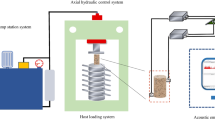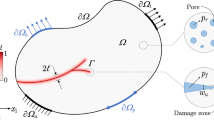Abstract
Natural and laboratory observations show that shear ruptures (faults) can propagate with extreme dynamics (up to intersonic rupture velocities) through intact materials and along pre-existing faults with frictional and coherent (bonded) interfaces. The rupture propagation is accompanied by significant fault strength weakening in the rupture head. Although essential for understanding earthquakes, rock mechanics, tribology and fractures, the question of what physical processes determine how that weakening occurs is still unresolved. The general approach today to explain the fault weakening is based upon the strong velocity-weakening friction law according to which the fault strength drops rapidly with slip velocity. Different mechanisms of strength weakening caused by slip velocity have been proposed including thermal effect, high-frequency compressional waves, expansion of pore fluid, macroscopic melting and gel formation. This paper proposes that shear ruptures of extreme dynamics propagating in intact materials and in pre-existing frictional and coherent interfaces are governed by the same recently identified mechanism which is associated with an intensive microcracking process in the rupture tip observed for all types of extreme ruptures. The microcracking process creates, in certain conditions, a special fan-like microstructure shear resistance of which is extremely low (up to an order of magnitude less than the frictional strength). The fan-structure representing the rupture head provides strong interface weakening and causes high slip and rupture velocities. In contrast with the velocity-weakening dependency, this mechanism provides the opposite weakening-velocity effect. The fan-mechanism differs remarkably from all reported earlier mechanisms, and it can provide such important features observed in extreme ruptures as: extreme slip and rupture velocities, high slip velocity without heating, off-fault tensile cracking, transition from crack-like to pulse-like rupture mode at variation in loading conditions, dramatic embrittlement of hard rocks at highly confined compression, abnormally low transient strength of hard rocks at high confining stresses, etc. All these questions are discussed in the paper.














Similar content being viewed by others
References
Ben-David O, Rubinstein SM, Fineberg J (2010) Slip-stick and the evolution of frictional strength. Nature 463:76–79
Ben-Zion Y (2001) Dynamic ruptures in recent models of earthquake faults. J Mech Phys Solids 49:2209–2244
Bowden FP, Tabor D (2001) The friction and lubrication of solids. Oxford Univ Press, Oxford
Brune JN, Henyey TL, Roy RF (1969) Heat flow, stress, and rate of slip along the San Andreas fault, California. J Geophys Res 74:3821–3827
Di Toro G, Goldsby DL, Tullis TE (2004) Friction falls towards zero in quartz rock as slip velocity approaches seismic rates. Nature 427:436–439
Fuller KNG, Fox PG, Field JE (1975) Temperature rise at tip of fast-moving cracks in glassy polymers. Proc R Soc Lond A 341:537
Ghaffari HO, Thompson BD, Young RP (2014) Complex networks and waveforms from acoustic emissions in laboratory earthquakes. Nonlinear Process Geophys 21:763–775
Griffith WA, Rosakis A, Pollard DD, Ko CW (2009) Dynamic rupture experiments elucidate tensile crack development during propagating earthquake ruptures. Geology 37(9):795–798
Heaton TH (1990) Evidence for and implications of self-healing pulses of slip in earthquake rupture. Phys Earth Planet Inter 64(1):1–20
Horii H, Nemat-Nasser S (1985) Compression-induced micro-crack growth in brittle solids: axial splitting and shear failure. J Geophys Res 90:3105–3125
Kanamori H, Heaton TH (2000) Microscopic and macroscopic physics of earthquakes. In: Rundle JB, Turcotte DL, Klein W (eds) Geophys. Mono. Series, Vol. 120, Geo complexity and the physics of earthquakes. American Geophysical Union, Washington DC, pp 147–163
King GCP, Sammis CG (1992) The mechanisms of finite brittle strain. PAGEOPH 138:611–640
Lachenbruch AH (1980) Frictional heating, fluid pressure, and the resistance to fault motion. J Geophys Res 85:6097–6112
Lei X, Kusunose K, Rao MVMS, Nishizawa O, Satoh T (2000) Quasi-static fault growth and cracking in homogeneous brittle rock under triaxial compression using acoustic emission monitoring. J Geophys Res 105(B3):6127–6139
Lu X, Lapusta N, Rosakis AJ (2010) Pulse-like and crack-like dynamic shear ruptures on frictional interfaces: experimental evidence, numerical modeling, and implications. Int J Fract. doi:10.1007/s10704-010-9479-4
Lykotrafitis G, Rosakis AJ, Ravichandran G (2006) Self-healing pulse-like shear ruptures in the laboratory. Science 313:1765–1768
Magloughlin JF, Spray JG (1992) Frictional melting processes and products in geological materials: introduction and discussion. Tectonophysics 204:197–206
Melosh HJ (1979) Acoustic fluidization: a new geologic process? J Geophys Res 84:7513–7520
Ngo D, Huang Y, Rosakis A, Griffith WA, Pollard D (2012) Off-fault tensile cracks: a link between geological fault observations, lab experiments, and dynamic rupture models. J Geophys Res 117:B01307. doi:10.1029/2011JB008577
Ohnaka M, Kuwahara Y (1990) Characteristic features of local breakdown near a crack-tip in the transition zone from nucleation to unstable rupture during stick-slip shear failure. Tectonophysics 175:197–220
Ohnaka M, Shen L-F (1999) Scaling of the shear rupture process from nucleation to dynamic propagation: implications of geometric irregularity of the rupturing surface. J Geophys Res 104(B1):817–844
Ortlepp WD (1997) Rock fracture and rockbursts. The South African Institute of Mining and Metallurgy, Johannesburg
Peng S, Johnson AM (1972) Crack growth and faulting in cylindrical specimens of Chelmsford granite. Int J Rock Mech Min Sci 9:37–86
Reches Z, Lockner DA (1994) Nucleation and growth of faults in brittle rocks. J Geophys Res 99:18159–18173
Rice JR (2006) Heating and weakening of faults during earthquake slip. J Geophys Res 111:B05311. doi:10.1029/2005JB004006
Richards PG (1976) Dynamic motions near an earthquake fault: a three-dimensional solution. Bull Sesmol Soc Am 66:1–32
Rosakis AJ (2002) Intersonic shear cracks and fault ruptures. Adv Phys 51(4):1189–1257
Rosakis AJ, Samudrala O, Coker D (1999) Cracks faster than the shear wave speed. Science 284:1337–1340
Rubinstein SM, Cohen G, Fineberg J (2004) Detachment fronts and the onset of dynamic friction. Nature 430:1005–1009
Rummel F, Fairhurst C (1970) Determination of the post-failure behavior of brittle rock using a servo-controlled testing machine. Rock Mech Rock Eng 2(4):189–204
Samudrala O, Huang Y, Rosakis AJ (2002) Subsonic and intersonic shear rupture of weak planes with a velocity weakening cohesive zone. J Geophys Res 107(B8):2170. doi:10.1029/2001JB000460
Sibson R (1992) Power dissipation and stress levels during seismic faulting. J Geophys Res 85:6239–6247
Tarasov BG (2010) Superbrittleness of rocks at high confining pressure. Keynote Address in Fifth International Seminar on Deep and High Stress Mining, Santiago, Chile, pp 119–133
Tarasov BG (2014) Hitherto unknown shear rupture mechanism as a source of instability in intact hard rocks at highly confined compression. Tectonophysics 621:69–84
Tarasov BG, Guzev MA (2013) New insight into the nature of size dependence and the lower limit of rock strength. In: Proceedings 8th international symposium on rockbursts and seismicity in mines, St-Petersburg, Russia, pp 31–40
Tarasov BG, Potvin Y (2013) Universal criteria for rock brittleness estimation under triaxial compression. Int J Rock Mech Min Sci 59:57–69
Tarasov BG, Randolph MF (2011) Superbrittleness of rocks and earthquake activity. Int J Rock Mech Min Sci 48:888–898
Tarasov BG, Randolph MF (2016) Improved concept of lithospheric strength and earthquake activity at shallow depths based upon the fan-head dynamic shear rupture mechanism. Tectonophysics 667:124–143
Wawersik WR, Fairhurst C (1970) A study of brittle rock fracture in laboratory compression experiments. Int J Rock Mech Min Sci 7:561–575
Xia K, Rosakis AJ, Kanamori H (2004) Laboratory earthquakes: the sub-Raleigh-to supershear rupture transition. Science 3003:1859–1861
YouTube (2016) Fan-hinged shear, uploaded by Boris Tarasov. https://youtu.be/_-AUzCEw35M. Accessed 31 July 2016
Acknowledgments
The author acknowledges the support provided by the Centre for Offshore Foundation Systems (COFS) at the University of Western Australia, which was established under the Australian Research Council’s Special Research Centre scheme and is currently supported as a node of the Australian Research Council Centre of Excellence for Geotechnical Science and Engineering.
Author information
Authors and Affiliations
Corresponding author
Rights and permissions
About this article
Cite this article
Tarasov, B. Shear Fractures of Extreme Dynamics. Rock Mech Rock Eng 49, 3999–4021 (2016). https://doi.org/10.1007/s00603-016-1069-y
Received:
Accepted:
Published:
Issue Date:
DOI: https://doi.org/10.1007/s00603-016-1069-y




